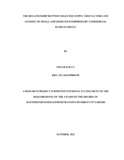| dc.description.abstract | Most research on Small and Medium Enterprises (SMEs) focused on lack of access to credit due to factors inherent with the SMEs, for example opaqueness, information asymmetry, high failure rates, and lack of collateral. SMEs make a significant contribution to social economic and political infrastructure of developed and developing countries. SMEs increase per capita income and output, create employment opportunities and enhance regional economic balance through industrial dispersal. The researcher carried out a study on factors that banks consider before lending to SMEs including: SME sector profitability, relationship with a corporate customer, strategic focus, level of competition, interest rates in the economy, and the cost to serve SMEs. The objective of this study was to determine the relationship between selected supply-side factors and lending to SMEs by commercial banks in Kenya. The study used descriptive research design and this was chosen because it enabled the researcher to generalize the findings to a larger population and allowed analysis of the relationship of variables under study using linear regression. The population of this study consisted of the forty four commercial banks in Kenya. The study collected primary data using a semi-structured questionnaire. Secondary data was collected from the Central Bank of Kenya (CBK) showing the level of interest rates in the economy for the period covering 2004 to 2013. Descriptive statistics such as means, standard deviation and frequency distribution were used to analyze the data. The study found the following: First, that commercial banks found the SME sector in Kenya very profitable and therefore made it a core part of their strategy. Secondly, most banks diversified into SME segment making the sector very competitive. Thirdly, that the interest rates in the market were highly unpredictable. Fourthly, banks found the cost of serving SMEs to be similar to that of serving their other customers due to automation. Fifthly, banks had a very good relationship with their corporate customers but still did lending to non-connected SMEs. The study concluded that equating all independent variables to zero, the level of lending to SMEs by commercial banks was 0.116. Profitability influenced the banks level of lending to SMEs most (at 58%) followed by interest rates (50%). The study recommended that government should prioritize focus on SMEs by: putting in place a legal, judicial and regulatory environment that fully supports SMEs; establishing a SME Bank to provide long term funding; The CBK should review its prudential guidelines to de-emphasize need for fixed collateral and encourage cash flow lending, have SME segment profitability reporting to measure SME contribution to the industry and the economy, and finally together with the banks and other government agencies, to come up with a standard definition of a SME, collate information on SMEs to understand them and make better decisions on the sector. | en |

